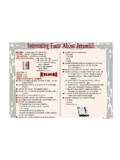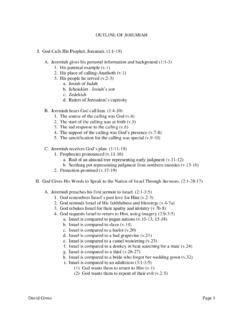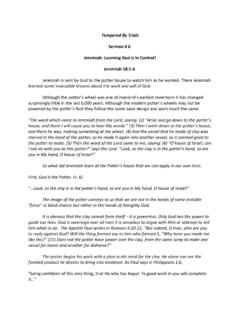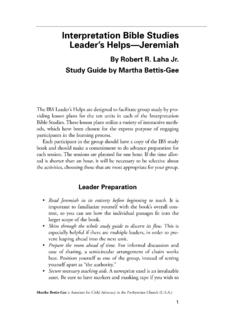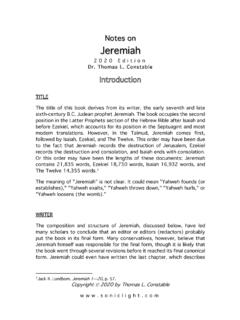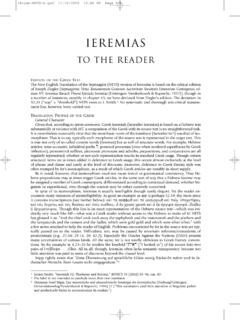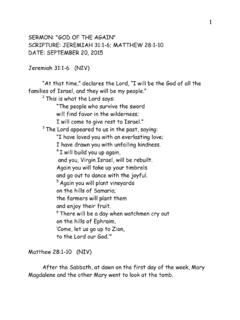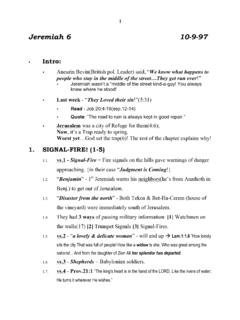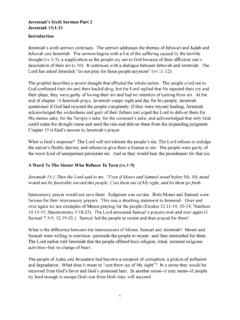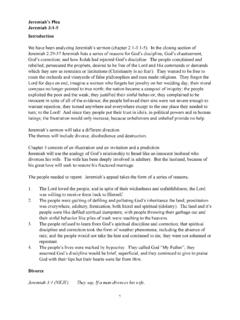Transcription of JEREMIAH 18:1-6 - templebaptch.com
1 T HE P OTTER AND THE C LAY. J EREMIAH 18:1-6 . Text: JEREMIAH 18:3. ( JEREMIAH 18:3) "Then I went down to the potter's house, and, behold, he wrought a work on the wheels.". Introduction: God uses many images to describe His relationship to His people. He speaks of the shepherd and sheep relationship, the husband and wife relationship, a Father and His children, just to name a few. All of these are wonderful examples and teach us many needed and valuable lessons about life, ourselves and our Lord. However, while we like sheep are protected and provided for by the shepherd, and as a wife, we are loved without condition by the husband and like children we are constantly under the Father's loving watch care, there is another facet of our lives that needs to be considered.
2 The Lord did not save us just so we could go to Heaven and miss Hell. He saved our souls so that we might be actively engaged in His service here on the earth. -1- Now, if we are to be His servants, we are going to need His power to get the job done. A child of God should never think that he can live the Christian life on his own. John 15:5 makes our dependence upon the Lord crystal clear. Therefore, perhaps the greatest portrait of God and His people to be found in the entire Bible, related to this matter of service, is this picture of the Potter and the Clay.
3 In these brief verses, we can see the plan of the Potter on display. Let's consider the subject, Lessons Learned from the Potter. 1. THE MISSION OF THE POTTER (1-3). ( JEREMIAH 18:1-3) "The word which came to JEREMIAH from the LORD, saying, {2} Arise, and go down to the potter's house, and there I will cause thee to hear my words. {3} Then I went down to the potter's house, and, behold, he wrought a work on the wheels.". A. His Intent - The Potter has a singular purpose. He desires to produce vessels that will -2- 1. Reap a profit, that 2.
4 Will be found useful 3. Will bring honor unto Himself. Illustration: This is God's intention as well. He excels in taking old worthless clay and transforming it by His grace into vessels of honor and glory. He takes those things that are the "offscouring of all things", 1 Cor. 4:13, and turns them into vessels of honor. (1 Corinthians 4:13) "Being defamed, we entreat: we are made as the filth of the world, and are the offscouring of all things unto this day.". Jesus saves the sinner by His grace and then He begins the process of changing that vile sinner into a vessel that will produce a profit for the Kingdom of God, one that will be useful to Him in His work, and one that brings honor and glory to His Name.
5 God is interested in taking the worst He can find and changing it into the best Heaven has to offer. B. His Ingredients - In order to accomplish this lofty goal, the Potter must work with materials that leave much to be desired. -3- Illustration: The condition of the clay as it is found: The clay as found in the ground is not suitable for use. It is dug out and brought to the vicinity of the pottery and allowed to weather for weeks. The dry material is then dumped into a cement-lined tank or wooden trough and covered with water. When the lumps have softened they are stirred in the water until all have disintegrated and a thin slimy mud or "slip" has been formed.
6 In coast cities-the potteries are all near the sea, as the sea-water is considered better for the "slipping". process. The slip is drawn off into settling tanks. All stones and lumps remain behind. When the clay has settled, the water is drawn off and the plastic material is worked by treading with the feet. The clay used on the Syrian coast is usually a mixture of several earths, which the potters have learned by experience, gives the right consistency. The prepared clay is finally packed away and allowed to stand another six months before using, during which time the quality, especially the plasticity, is believed to improve.
7 -4- In other words, the clay, as it is taken from the ground, is worthless. It must be transformed into a useable state and this is a process that takes time and energy on the part of the Potter. This is a perfect portrait of sinners. We are worthless to God in our natural condition. However, He is able to see the vessels that we can become. Therefore, He begins the process that will bring us to a place of usefulness. He digs us out, dries us up and washes us clean. This is a clear picture of the process a sinner must go through prior to salvation.
8 The heart is pricked and the conviction of God begins to work in the heart. The sinner is lead along in little baby steps until he reaches the place where he receives Christ as Savior. At that point, God begins the molding process. It's seems pretty evident that the Lord doesn't have a whole lot to work with when He finds us. After all, we are all made from the same clay. C. His Instruments - The potter uses several implements to bring the clay to a place where it is usable. 1. A Shovel -5- This is the tool he uses to dig the clay from the earth.
9 This is a picture of the Spirit of God who comes to where are in sin and speaks to us in convicting power and draws us to Jesus. 2. A Mallet After the clay has been cleansed and processed, it is laid on a table and beaten with a wooden mallet. The Potter does this to remove any air bubbles that might be trapped in the clay. If he doesn't the air bubble will form a pocket that will produce a weak spot and cause the vessel to be fragile and unusable. Illustration: This is a picture of the trials, calamities and chastisements of life that tend to work together to shape us in the image of the Lord Jesus Christ 2 Cor.
10 4:17. (2 Corinthians 4:17) "For our light affliction, which is but for a moment, worketh for us a far more exceeding and eternal weight of glory;". 3. The Wheels The potter is in control of the wheels at all times. -6- 4. His Hands While the clay spins around on the wheels, it is never out of contact with the Potter's hands. 2. THE MINISTRY OF THE POTTER. (v 4). ( JEREMIAH 18:4) "And the vessel that he made of clay was marred in the hand of the potter: so he made it again another vessel, as seemed good to the potter to make it.". A.


